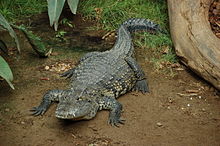|
Morelet's crocodile
Morelet's crocodile (Crocodylus moreletii), also known as the Mexican crocodile or Belize crocodile, is a modest-sized crocodilian found only in the Atlantic regions of Mexico, Belize and Guatemala.[2][5] It usually grows to about 3 metres (10 ft) in length. It is a species at least concern for extinction according to the International Union for Conservation of Nature.[2] The species has a fossil record in Guatemala.[6] Taxonomy and etymologyMorelet's crocodile was first described in 1850 in Mexico by the French naturalist Pierre Marie Arthur Morelet. The species was subsequently named after him.[7][8] It was long confused with the American and Cuban crocodiles because of similar characteristics and an ambiguous type locality. It was not generally accepted as a separate species until the 1920s. EvolutionThe genus Crocodylus likely originated in Africa and radiated outwards towards Southeast Asia and the Americas,[9] although an Australia/Asia origin has also been considered.[10] Phylogenetic evidence supports Crocodylus diverging from its closest recent relative, the extinct Voay of Madagascar, around 25 million years ago, near the Oligocene/Miocene boundary.[9] PhylogenyBelow is a cladogram based on a 2018 tip dating study by Lee & Yates simultaneously using morphological, molecular (DNA sequencing), and stratigraphic (fossil age) data,[11] as revised by the 2021 Hekkala et al. paleogenomics study using DNA extracted from the extinct Voay.[9]
Characteristics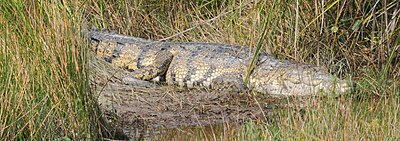  Morelet's crocodile is similar in appearance and morphology to the Cuban and the larger American crocodiles. This species has a broad snout with 66 to 68 teeth when they are fully mature. It is grayish-brown in color with dark bands and spots on the body and tail. This is similar to other crocodiles, like the American crocodile, but the Morelet’s is somewhat darker. Juvenile crocodiles are bright yellow with dark bands. The iris is silvery brown. They have four short legs, giving them a rather sprawling gait, and a long tail, which is used for swimming. The hind feet are webbed. Despite their short legs, they are fast runners.[7] Morelet's crocodile is smaller than most other crocodiles, though it is larger than the dwarf crocodile (Osteolaemus tetraspis). Adult males are typically larger than females. The average adult Morelet's crocodile is about 2.1 m (6 ft 11 in), with a typical length range of 1.5 to 2.7 m (4 ft 11 in to 8 ft 10 in) (the lower measurement representing the mean total length of a female at sexual maturity which is attained at roughly 7–8 years of age in the wild).[12][13] Almost all crocodiles in excess of 2.5 m (8 ft 2 in) are males and at this advanced stage of maturity, the male goes through a significant change in skull osteological morphology as the skull appears to increase in broadness and robustness.[14] Large adult males can attain a length of 3 m (10 ft), anything in excess of this is considered exceptionally rare for this species however the species has a maximum reported length of 4.5 m (15 ft), with two other outsized specimens reportedly measuring 4.1 and 4.3 m (13 and 14 ft), respectively.[13][15][16] One mature adult specimen measuring 2.84 m (9 ft 4 in) and weighing 110 kg (240 lb) had a bite force of 4,399 N (989 lbf).[17] The weight of a large 3 m (10 ft) wild male crocodile is estimated to average around 150 kg (330+3⁄4 lb), although mass is likely much more in outsized individuals.[13][18] One large male with a presumed total length of around 3.5 m (11 ft 6 in) weighed about 250 kg (550 lb).[19] Another large individual measuring 3.3 m (10 ft 10 in) in length weighed 180 kg (400 lb).[20] Distribution and habitat Morelet's crocodile can be found in freshwater habitats in Central America and along the Gulf of Mexico stretching through Belize, Guatemala, and to Mexico.[21] The Belizean pine forests are an example of the type of ecoregion in which they occur.[22] In their freshwater habitats, they prefer isolated areas that are secluded. This species of crocodile can mainly be found in freshwater swamps and marshes which are located inland, and in large rivers and lakes.[23] Both of these habitats are forested to help add cover.[7] The Morelet can also be found along the coast in brackish waters[2] and the grassy savannas on the Yucatán Peninsula.[24] These crocodiles become much more distributed during the rainy seasons when flooding occurs and it is easier for them to move elsewhere.[24] Juvenile crocodiles live in very dense cover to protect them from other predators that might be in the area and will remain there until they become older and able to fend for themselves. Adult crocodiles are known to dig out burrows during dry seasons in their area.[7] The range of this crocodile can overlap with the American crocodile, which can sometimes lead to them being confused with one another. Morelet's crocodile generally prefers mainland freshwater habitats, while American crocodiles in the shared range are typically found in areas of saline mangrove, often on cays or atolls.[2] Hybridization between the two species has been reported in Mexico and coastal Belize.[2] Recently, the Morelet's crocodile has been introduced into the Rio Grande (Rio Bravo in Mexico).[25] Several newspaper outlets on the Mexican side of the border report of reptiles inhabiting the river appearing not to be the American alligator which is native to Texas, but the Morelet's crocodile which is native to Tamaulipas from San Fernando southward.[26][27] Crocodiles have been seen in the cities of Matamoros,[28][29][30] Reynosa[31][32][33][34][35][36] and as far north as Nuevo Laredo.[37][38] The sightings have prompted several municipal police departments to put up signs warning people about entering the river.[39] Biology and behavior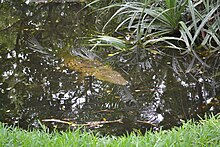 Hunting and dietLike most crocodilians, Morelet's crocodiles are highly opportunistic and will prey on practically anything that they can overpower that comes in their territories.[40] Juvenile crocodiles feed largely on fish and insects until they become bigger and more capable of bringing down larger prey.[23] Adults largely prey on small mammals, birds, other reptiles and fish, as well as gastropods, crustaceans and other invertebrates.[16][40][41] Dogs and goats have been taken by this species, including a record of a 2.9 m (9 ft 6 in) adult killing an English sheepdog which weighed at least 35 kg (77 lb).[42] Adults have also been recorded eating even larger animals, including cattle and tapirs, although these have been cases of scavenging on carcasses, with the tapir having been killed by a jaguar.[43] Crocodiles have been known to be cannibalistic towards smaller specimens. The species has attacked humans on multiple occasions and at least 12 documented human fatalities have occurred.[44] Despite the relatively small size of the species, large adult Morelet's are capable of overpowering a human. Due to partial consumption, recorded fatal attacks are likely predatory rather than defensive in nature.[45][46][47] The only natural predator of the Morelet's crocodile is the jaguar. Predation of a Morelet’s crocodile by a jaguar was captured for the first time on a camera trap in the Calakmul Biosphere Reserve of Yucatán, Mexico in 2019.[48] Reproduction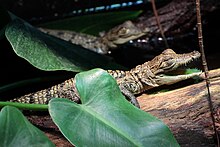 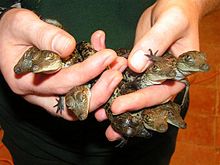 Breeding usually takes place between April and June[24] and the eggs are laid before the start of the rainy season. Morelet's crocodiles are unique among North American crocodiles in that they build mound nests only, and not mound and hole nests. These mound nests are about 3 m (10 ft) wide and 1 m (3 ft 3 in) high and can be found near the water or on floating vegetation. A female crocodile can lay between 20 and 45 eggs and nests have been found containing eggs from more than one female. The eggs are buried and the nests are guarded by females. The eggs usually hatch after 80 days of incubation[24] and hatchlings are normally about 17 cm (6+1⁄2 in) long.[5] After the eggs have hatched the female crocodile will carry her young to the water, where they are protected by both parents. Females are highly protective of their young and have reportedly been observed to aggressively displace intruders and humans if distress calls of the baby crocodiles are heard and even father crocodiles have been observed to spring to the defense of young crocodiles.[49][50] In captivity, juvenile crocodiles—but never hatchlings—are treated aggressively by adult crocodiles.[51] ConservationMorelet's crocodile has long been threatened by habitat destruction and illegal hunting.[52] Both of these factors have significantly lowered their populations. It was hunted for its hide during the 1940s and 1950s[52] because high-quality leather can be made from their skins.[53][54] Notes
References
External linksWikimedia Commons has media related to Crocodylus moreletii. Wikispecies has information related to Crocodylus moreletii.
|
|||||||||||||||||||||||||||||||||||||||||||||||||||||||||||||||||||||||||||||||||||||||||||||||||||||||||||||||||||||||||||||||||||||||||||||
Portal di Ensiklopedia Dunia
